Using equipment in inland (freshwater) waters
Labelling your gear correctly
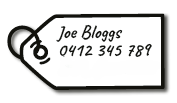
Hoop nets and bait traps must be attached to a tag that remains above the water’s surface with the recreational fisher’s full name and telephone number clearly and legibly written.
Lines, hooks and jigs
Lines
You must not leave a line or rod unattended. Your line must be in sight and within 50m of you.
Hooks and jigs
One hook is defined as:
- a single hook
- a group of 4 hooks linked together by the eye
- a lure
- a squid jig
- a bait jig.
Keeper hook
A keeper hook:
- is defined as an assembly of 2 hooks arranged to keep bait in one position at the line
- has one hook attached to the end of the line and 1 hook that can slide down the line and touch the attached hook
Bait jig
A bait jig is:
- A continuous series of no more than 6 unbaited lures with hooks less than 2 cm in length, attached to a line with a total rig length of up to 3 m.
In inland waters, each licensed or exempt fisher may use a maximum of 2 lines per person ((can be a combination of either hand lines or rods with reels), with no more than 2 hooks or 1 bait jig attached to each line.
Baited lines
Baited lines are lines without hooks, Baited lines must not have any hooks tied to them.
A maximum of 10 baited lines (per licenced or exempt fisher) may be used and possessed in any inland water.
Bait pumps
Hand-operated suction bait pumps with a barrel diameter not exceeding 8.5cm may be used. A sieve can be used in conjunction with the pump.

A maximum of one bait pump (per licensed or exempt fisher) can be used in inland waters. You must not use a bait pump as a tool to dig with.
Bait nets (Hauling nets)
A bait net must not exceed 6m in length. Hauling ropes attached to each end also must not exceed 6m. Bait nets do not include cast nets, which are illegal equipment.
A licensed or exempt fisher can use a maximum of 1 bait net to collect bait from permitted inland waters. Bait nets must not be used in restricted waters.
Permitted waters
A bait net may only be used in the following waters:
- Any lake, swamp, marsh or lagoon
- Curdies River between the ‘Narrows’ and the bridge on the Great Ocean Road at Peterborough
- Fitzroy River downstream from the boat ramp.
- Glenelg River downstream from the southern boundary of the lower Glenelg National Park
- Hopkins River downstream from Rowans Lane to within 200m of the mouth of the river
- Merri River downstream from the Princes Highway
- Snowy River downstream from the Government Wharf at Marlo
- Surrey River downstream from the Princes Highway at Narrawong
- Wimmera River downstream from the bridge on the Stawell-Marnoo Road to Lake Hindmarsh.
You must not tow, drag or haul any net behind a motor under propulsion in any Victorian waters, marine or inland.
Gaffs
Gaffs (including barbed flying gaffs) can only be used to assist anglers to land fish (other than invertebrates).
Barbless gaffs are a barbless hook or series of barbless hooks (with or without a handle).
A barbed flying gaff consists of a single hook (with or without a barb) with a rope or cord attached to both the hook and a rigid pole, such that the hook detaches from the pole when it penetrates the body of a fish.
Harpoons are not permitted.
Bait traps
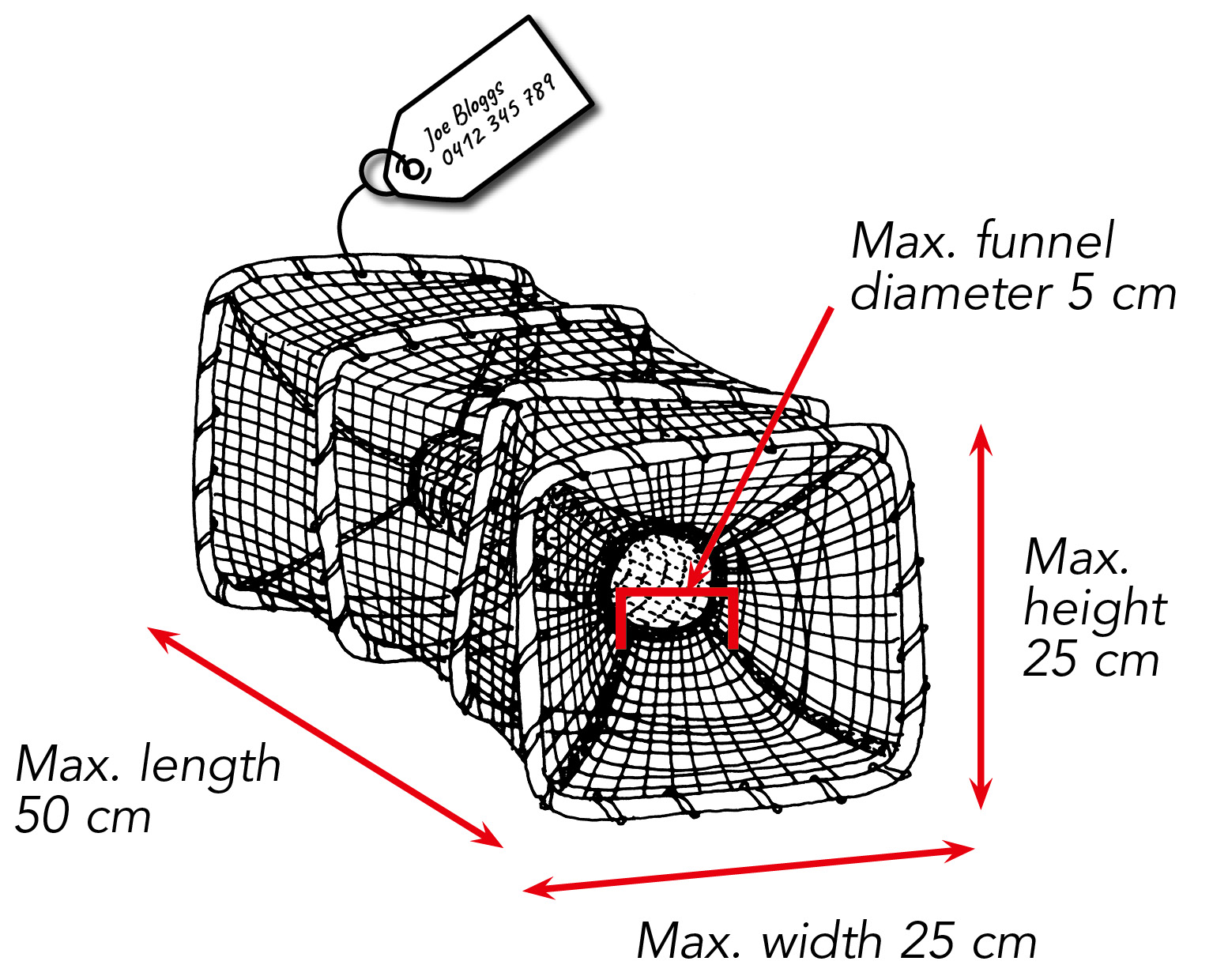
Funnel entrance diameter must not exceed 5cm. The height of the trap must be no more than 25cm. The size of the trap must be less than 25cm wide and 50cm long.
A maximum of 2 labelled bait traps (per licensed or exempt fisher) may be used in or on any inland water.
Dip/landing net
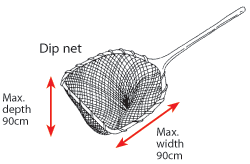
A dip net consists of an open-faced net with a width and depth not exceeding 90cm, attached to a handle.
A licensed or exempt fisher can use 1 dip net to take a variety of fish or invertebrate species, with or without a light.
Hoop nets
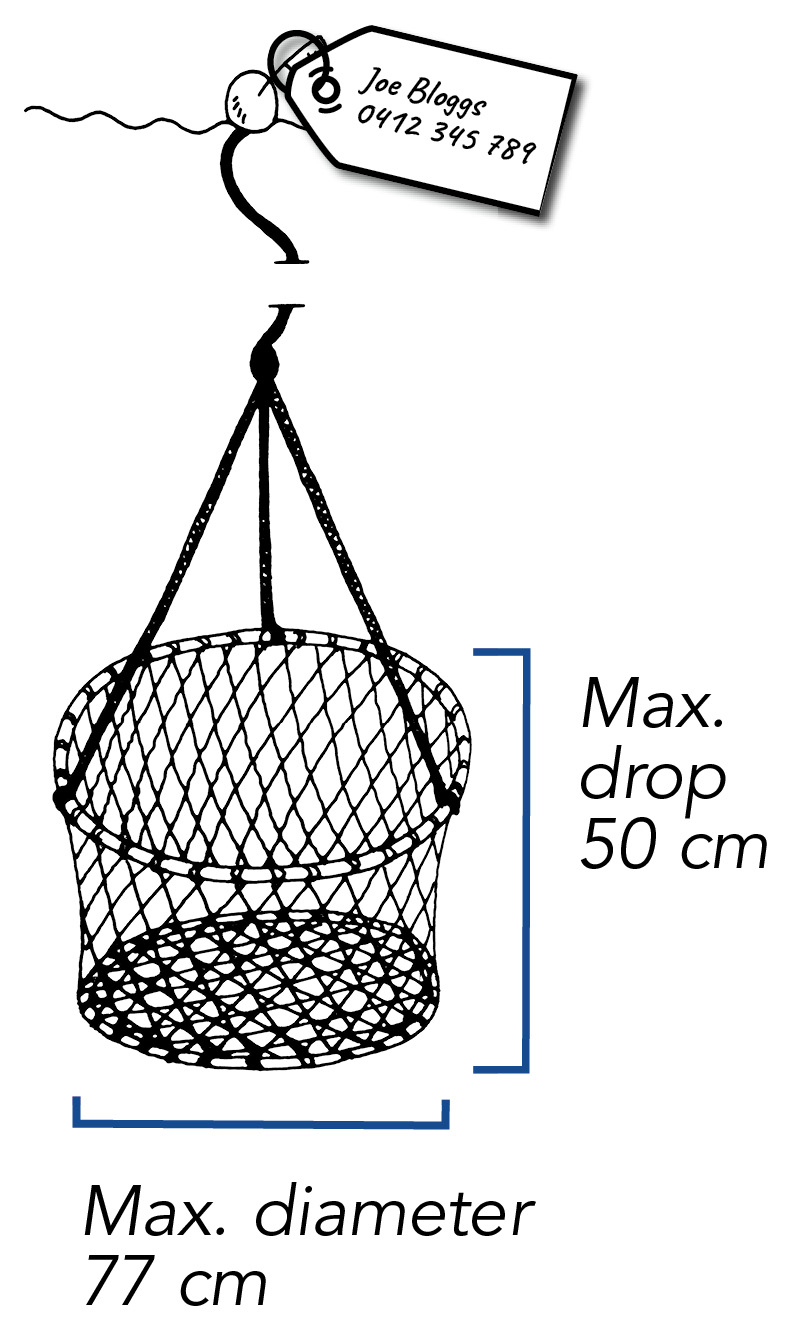
A hoop net is a cylindrical net open at the top, consisting of 1 or 2 hoops not exceeding 77cm in diameter. The net must not have a drop of more than 50cm. Nets must be labelled if set from a boat or left unattended. The label must float at the water's surface, and must clearly display the recreational fisher's full name and telephone number clearly and legibly written.
Up to 5 hoop nets labelled hoop nets per licensed or exempt fisher may be used or possessed in or on the following 11 creek/river systems:
- Carrol's Creek
- Glenelg River system (excluding Rocklands Reservoir)
- Goulburn River system (excluding Lake Eildon)
- the Kiewa River system
- the Latrobe River system
- the Mitta Mitta River system (excluding Lake Dartmouth)
- the Ovens River system
- Ryans Creek
- Tarra River system
- Waranga Basin
- Wodonga Creek
In all other inland waters, a combined maximum total of 10 hoop nets and/or open top lift nets can be used.
Open top lift nets
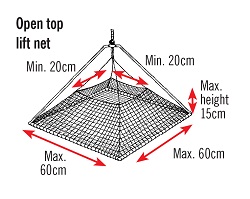 Open top lift nets are any square or rectangular pot or net open at the top not exceeding 60 cm long or more than 60 cm wide or with a mesh net height of no more than 15 cm and a top opening of no less than 20 cm by 20 cm without
Open top lift nets are any square or rectangular pot or net open at the top not exceeding 60 cm long or more than 60 cm wide or with a mesh net height of no more than 15 cm and a top opening of no less than 20 cm by 20 cm without
any internal device. They are designed for catching yabbies.
Open top lift nets can be used in private waters such as dams.
Restricted waters
Open top lift nets can be used in most public waters but can’t be used in the following 11 river/creek systems:
- Carrol's Creek
- Glenelg River system (excluding Rocklands Reservoir)
- Goulburn River system (excluding Lake Eildon)
- the Kiewa River system
- the Latrobe River system
- the Mitta Mitta River system (excluding Lake Dartmouth)
- the Ovens River system
- Ryans Creek
- Tarra River system
- Waranga Basin
- Wodonga Creek
In all other inland waters a combined maximum total of 10 hoop net and/or open top lift nets can be used.
Hand-cranked electric reels
These are permitted for use by recreational fishers if they have a hand cranking mechanism, are fitted to a conventional recreational fishing rod and can be hand held when retrieving fish. Other types of powered devices are considered commercial fishing equipment and cannot be used by recreational fishers. If a person with a disability has a legitimate need to use a powered device other than a hand-cranked electric reel, they may apply for a permit from the VFA.
